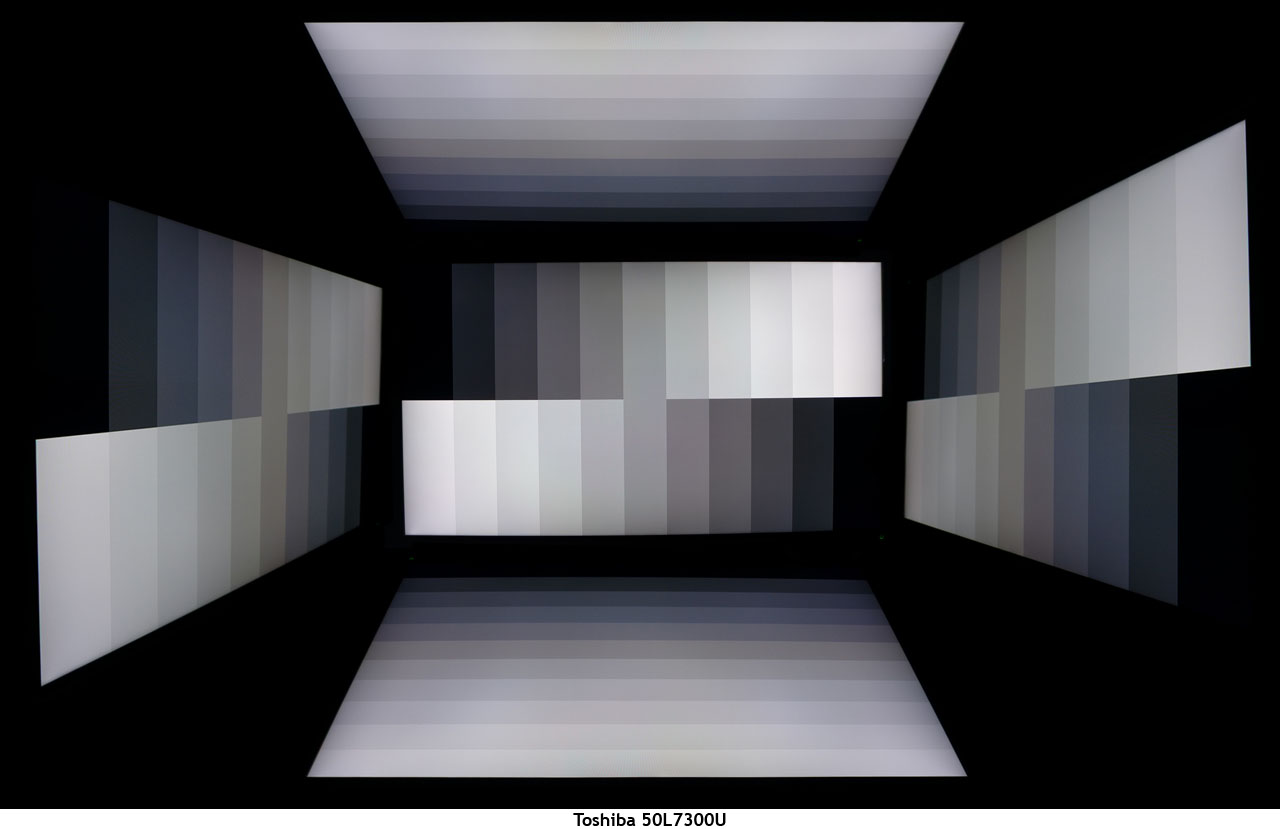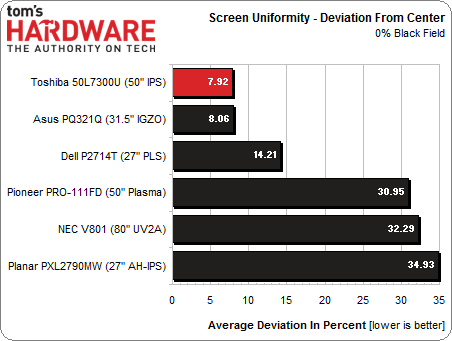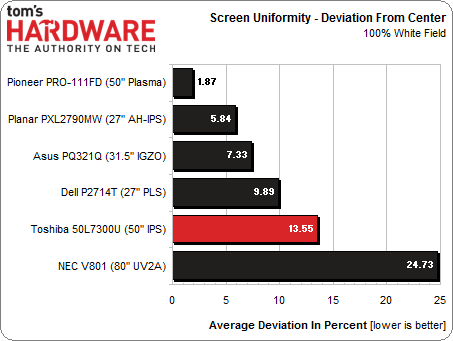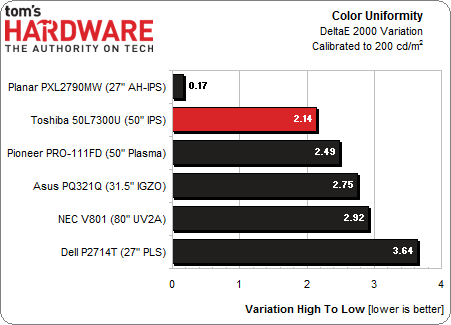Toshiba 50L7300U Review: A 50-Inch LED HDTV With Wi-Fi
You've seen us dramatically increase our display coverage over the last year, and now we're reviewing HDTVs too. Our first screen is Toshiba’s 50-inch L7300U Cloud TV with Wi-Fi. We run it through our lab and usability tests to see how it measures up.
Results: Viewing Angles And Uniformity
Off-axis image quality is super-important in any large-screen HDTV. Since only one person can sit in the center seat, everyone else on the couch is forced to watch at an angle. While most manufacturers claim large viewing angles of 170 degrees or more, 45 degrees is realistic to us. Given a 50-inch LCD panel viewed at eight feet, getting four people in front of it is probably a practical limit if everyone wants a decent picture.
With that said, the 50L7300U looks pretty good at the edge of our 45-degree cone. There is almost no reduction in brightness and the color shift is limited to medium brightness levels only. We see a slight green hue in the 30- to 50-percent bars of the side-to-side view. This is a great TV for family viewing. A larger screen would be even better, and Toshiba obliges by offering sizes up to 65 inches in the L7300U model line.
Screen Uniformity: Luminance
To measure screen uniformity, zero-percent and 100-percent full-field patterns are used, and nine points are sampled. In a change from previous reviews, we’re now comparing the results to other monitors we’ve measured. First, we establish a baseline measurement at the center of each screen. Then the surrounding eight points are measured and their values expressed as a percentage of the baseline, either above or below. This number gets averaged. It is important to remember that we only test the review sample each vendor sends us. Other examples of the same monitor can measure differently in this metric.
First up is black field uniformity.
One of the negative traits of early model LED-lit HDTVs was poor black field uniformity. It was pretty easy to see hotspots at the edges and corners of the screen. Modern panels largely minimize this flaw. The 50L7300U looks fantastic displaying a black field pattern. There are no visible hotspots; just a nice uniform tone.
Here’s the white field measurement.
Again, we get a pretty good number. But it doesn’t tell the whole story. Aside from the center measurement, the other eight values are within 10 cd/m2 of one another. That’s impressive for any LCD panel, large or small. Only a slight hotspot at the center keeps the 50L7300U from acing this test. And it’s a barely visible flaw at worst.
Get Tom's Hardware's best news and in-depth reviews, straight to your inbox.
Screen Uniformity: Color
To measure color uniformity, we display an 80-percent white field and measure the Delta E error of the same nine points on the screen. Then we simply subtract the lowest value from the highest to arrive at the result. A smaller number means a display is more uniform. Any value below three means a variation that is invisible to the naked eye.
The outcome is once again excellent. Planar's submission is a freak of nature. Any screen measuring less than three percent deviation will show no color uniformity flaws.
Current page: Results: Viewing Angles And Uniformity
Prev Page Results: Color Gamut And Performance Next Page Results: Pixel Response And Input Lag
Christian Eberle is a Contributing Editor for Tom's Hardware US. He's a veteran reviewer of A/V equipment, specializing in monitors. Christian began his obsession with tech when he built his first PC in 1991, a 286 running DOS 3.0 at a blazing 12MHz. In 2006, he undertook training from the Imaging Science Foundation in video calibration and testing and thus started a passion for precise imaging that persists to this day. He is also a professional musician with a degree from the New England Conservatory as a classical bassoonist which he used to good effect as a performer with the West Point Army Band from 1987 to 2013. He enjoys watching movies and listening to high-end audio in his custom-built home theater and can be seen riding trails near his home on a race-ready ICE VTX recumbent trike. Christian enjoys the endless summer in Florida where he lives with his wife and Chihuahua and plays with orchestras around the state.



